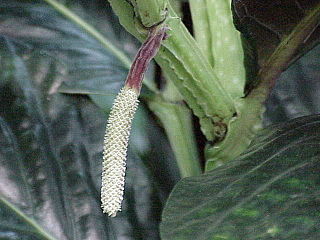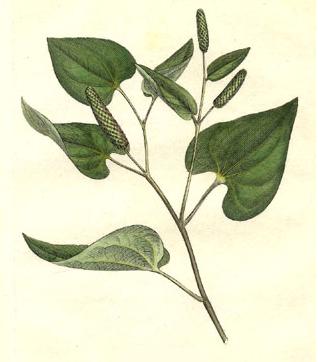
Piper, the pepper plants or pepper vines, is an economically and ecologically important genus in the family Piperaceae.

In the culinary arts, a spice is any seed, fruit, root, bark, or other plant substance in a form primarily used for flavoring or coloring food. Spices are distinguished from herbs, which are the leaves, flowers, or stems of plants used for flavoring or as a garnish. Spices are sometimes used in medicine, religious rituals, cosmetics, or perfume production. They are usually classified into spices, spice seeds, and herbal categories.For example, vanilla is commonly used as an ingredient in fragrance manufacturing. Plant-based sweeteners such as sugar are not considered spices.

Black pepper is a flowering vine in the family Piperaceae, cultivated for its fruit, which is usually dried and used as a spice and seasoning. The fruit is a drupe (stonefruit) which is about 5 mm (0.20 in) in diameter, dark red, and contains a stone which encloses a single pepper seed. Peppercorns and the ground pepper derived from them may be described simply as pepper, or more precisely as black pepper, green pepper, or white pepper.

Allspice, also known as Jamaica pepper, myrtle pepper, pimenta, or pimento, is the dried unripe berry of Pimenta dioica, a midcanopy tree native to the Greater Antilles, southern Mexico, and Central America, now cultivated in many warm parts of the world. The name allspice was coined as early as 1621 by the English, who valued it as a spice that combined the flavours of cinnamon, nutmeg, and clove.

Ras el hanout or rass el hanout is a spice mix found in varying forms in Maghreb including Tunisia, Algeria, and Morocco. The name means "head of the shop" in Arabic and implies a mixture of the best spices the seller has to offer. Ras el hanout is used in many savoury dishes, sometimes rubbed on meat or fish, or stirred into couscous, pasta or rice.

Berbere is a spice mixture whose constituent elements usually include chili peppers, coriander, garlic, ginger, Ethiopian holy basil (besobela) seeds, korarima, rue, ajwain or radhuni, nigella, and fenugreek. It is a key ingredient in the cuisines of Ethiopia and Eritrea. Berbere also refers to chili pepper itself.
Oleoresins are semi-solid extracts composed of resin and essential or fatty oil, obtained by evaporation of the solvents used for their production. The oleoresin of conifers is known as crude turpentine or gum turpentine, which consists of oil of turpentine and rosin.

Long pepper, sometimes called Indian long pepper or pippali, is a flowering vine in the family Piperaceae, cultivated for its fruit, which is usually dried and used as a spice and seasoning. Long pepper has a taste similar to, but sweeter and less pungent than, that of its close relative Piper nigrum – from which black, green and white pepper are obtained.

Cubebenes are a pair of chemical compounds, classified as sesquiterpenes, first isolated from Piper cubeba berries, known as cubebs.

Peranakan cuisine or Nyonya cuisine comes from the Peranakans, descendants of early Chinese migrants who settled in Penang, Malacca, Singapore and Indonesia, inter-marrying with local Malays. In Baba Malay, a female Peranakan is known as a nonya, and a male Peranakan is known as a baba. The cuisine combines Chinese, Malay, Javanese, South Indian, and other influences.

Piper auritum is an aromatic culinary herb in the pepper family Piperaceae, which grows in tropical Central America. Common names include hoja santa, yerba santa, hierba santa, Mexican pepperleaf, acuyo, tlanepa, anisillo, root beer plant, Vera Cruz pepper and sacred pepper.

Piper guineense is a West African species of Piper; the spice derived from its dried fruit is known as Ashanti pepper, Benin pepper, Edo pepper, false cubeb, Guinea cubeb, and called locally kale, kukauabe, masoro, etiñkeni, sasema, soro wisa, eyendo, eshasha by the Urhobo people, and oziza and uziza by the Igbo people of Nigeria. It is a close relative of cubeb pepper and a relative of black pepper and long pepper. Unlike cubeb, which is large and spherical in shape, Ashanti pepper grains are prolate spheroids, smaller and smoother than Cubeb pepper in appearance and generally bear a reddish tinge. The stalks of Ashanti pepper berries are also distinctly curved whilst those of cubeb pepper are completely straight. The terms West African pepper and Guinea pepper have also been used, but are ambiguous and may refer to grains of Selim or grains of paradise.

Grains of Selim are the seeds of a shrubby tree, Xylopia aethiopica, found in Africa. The seeds have a musky flavor and are used as a spice in a manner similar to black pepper, and as a flavouring agent that defines café Touba, the dominant style of coffee in Senegal. It is also known as Senegal pepper, Ethiopian pepper, and (historically) Moor pepper and Negro pepper. It also has many names in native languages of Africa, the most common of which is diarr in the Wolof language. It is called 'Etso' in the Ewe language of Ghana and Togo. It is sometimes referred to as African pepper or Guinea pepper, but these are ambiguous terms that may refer to Ashanti pepper and grains of paradise, among others.
The following outline is provided as an overview of and topical guide to herbs and spices:

Mesir Macunu is a traditional Turkish sweet associated with the city of Manisa. Earlier versions of Mesir macunu were not sweet, but rather spicy in flavor.

Sambal is an Indonesian chili sauce or paste, typically made from a mixture of a variety of chilli peppers with secondary ingredients such as shrimp paste, garlic, ginger, shallot, scallion, palm sugar, and lime juice. Sambal is an Indonesian loanword of Javanese origin. It originated from the culinary traditions of Indonesia and is also an integral part of the cuisines of Singapore, Malaysia, Brunei, and Sri Lanka. It has also spread through overseas Indonesian populations to the Netherlands and Suriname.

Paprika is a spice made from dried and ground red peppers. It is traditionally made from Capsicum annuum varietals in the Longum group, including chili peppers. Paprika can have varying levels of heat, but the chili peppers used for hot paprika tend to be milder and have thinner flesh than those used to produce chili powder. In some languages, but not English, the word paprika also refers to the plant and the fruit from which the spice is made, as well as to peppers in the Grossum group.

Kaeng hang le is a rich Northern Thai pork curry. Kaeng hang le is very popular in Northern Thailand, well-known as a specialty of the region. The curry differs from traditional northern Thai curries in several respects: it is typically eaten with long-grained rice, not sticky rice, and uses dried spices, which are commonly used in Burmese, but not northern Thai curries. The dish is commonly served as a festive dish in northern Thailand.

The history of spices reach back thousands of years, dating back to the 8th century B.C. Spices are widely known to be developed and discovered in Asian civilizations. Spices have been used in a variety of antique developments for their unique qualities. There were a variety of spices that were used for common purposes across the ancient world. Different spices hold a value that can create a variety of products designed to enhance or suppress certain taste and/or sensations. Spices were also associated with certain rituals to perpetuate a superstition or fulfill a religious obligation, among other things.





















